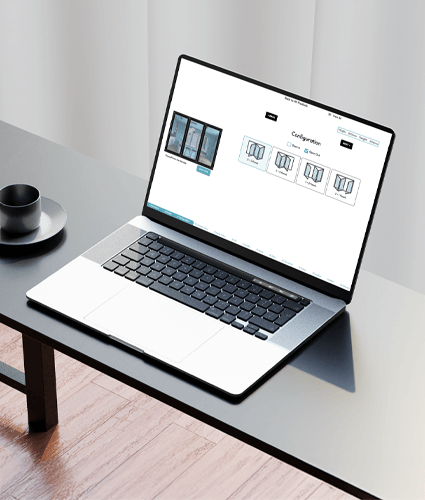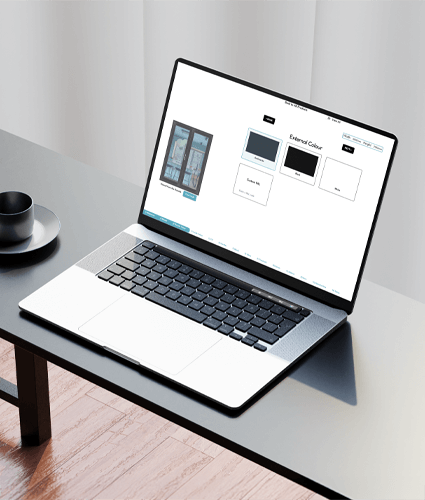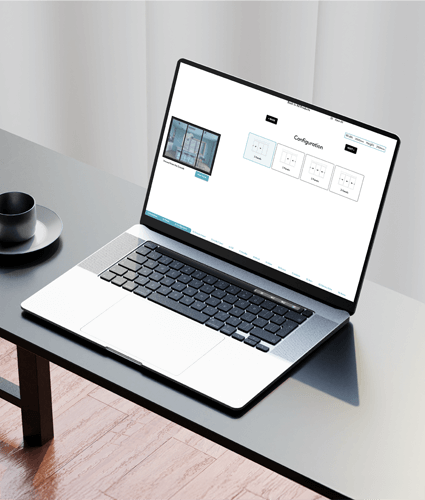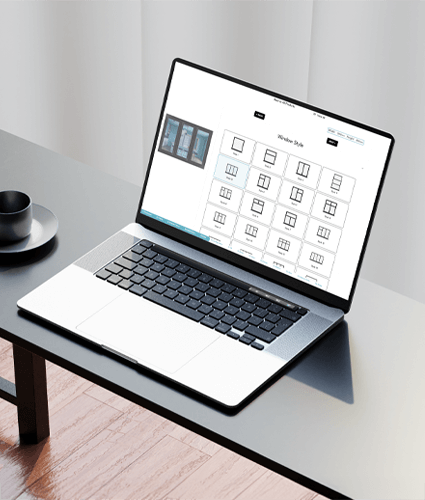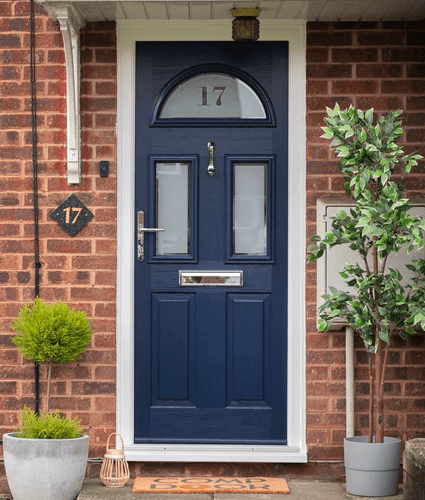
Design Your Door Here
Standard French Door Width and Height in the UK
French doors are known for their elegant design and seamless indoor-outdoor connection. But how do you pick the perfect French door for your home?
In this guide, we’ll explore standard and custom door sizes, styles, and materials, as well as accurate measurements and proper installation.
Read on to uncover the world of French doors and find your ideal fit for your home.
Choosing the Right French Door Dimensions for Your UK Home
French doors are celebrated for their elegant design and ability to create a seamless indoor-outdoor connection. How do you select the perfect French door for your home?
In this guide, we’ll delve into standard and custom door sizes, styles, materials, and tips for accurate measurements and proper installation.
French Door Size Guide
French doors are a popular choice for patio doors, combining beauty and functionality by allowing natural light to flood into your home and creating a seamless connection to your garden or patio area.
You can compare patio doors and French doors to determine which one suits you and your home best.
To find the perfect French door for your home, it’s essential to understand the dimensions of your door opening and the range of sizes available on the market.
Common French Door Sizes
Standard French door sizes generally vary from 30 to 72 inches in width and 79.5 to 81.6 inches in height, with typical sizes being 36, 48, and 60 inches wide.
Custom French door options are also available, allowing you to tailor the doors to fit specific spaces and maximize the amount of light entering your home.
When considering external French door sizes, it’s important to consider both standard sizes and the potential for custom options to ensure the perfect fit for your space.
Standard Dimensions for French Doors
French Door Sizes in Centimetres:
- Width: 180 cm
- Height: 210 cm
French Door Sizes in Inches:
- Width: 36 inches
- Height: 80 inches
Standard French door dimensions are designed to fit most door openings, making them a convenient choice for many homeowners. Typical widths are 36 inches, 48 inches, and 60 inches, offering a range of options for various spaces.
However, it’s important to note that the maximum width for exterior French doors is limited to around 1900mm. Larger widths can affect the load on the hinges and create too large an opening circle.
For height, standard French door heights range from 79.5 inches to 81.6 inches. This range ensures that most homeowners can find a suitable French door for their home without needing extensive customisation.
Customising French Door Sizes to Fit Your Needs
If standard widths and heights don’t suit your requirements, or if you have unique door openings or desire a more personalised touch, custom French door options are available.
These doors can be tailored to fit specific spaces, with widths reaching up to 9.84 feet when including sidelights.
Custom options are designed to maximise natural light, making them an excellent choice for creating a bright and airy environment.
Some custom options include aluminium bi-folding doors, offering a sleek, modern look while providing the flexibility of folding or sliding mechanisms.
These doors can accommodate a wide range of widths, making them versatile for homeowners with larger openings or unique architectural features.
Measuring Your French Door Opening
Accurate measurement of your door opening is one of the most crucial steps in ensuring security and a proper fit for your French doors. Here’s how to guarantee an appropriate fit:
Tools Needed for Measuring To measure your door opening accurately, you’ll need:
- Tape measure
- Pen or pencil
- Sketch of the door opening to record measurements
- An additional person for assistance
Creating a sketch of the door opening ensures all measurements are taken from the same point of reference, reducing the likelihood of mistakes.
Width Measurements To measure the width of your door opening:
- Measure at the top, middle, and bottom of the opening.
- Ensure you’re measuring the opening itself, not the existing doors or frames, for accuracy.
- Use the largest measurement as the final width for your French door to accommodate any minor irregularities.
Height Measurements When measuring the height of your door opening:
- Measure down the left and right sides of the opening.
- Measure the opening itself rather than the existing doors or frames.
- Use the largest measurement as the final height for your French door, allowing for any discrepancies.
By following these steps, you ensure a proper fit for your new French doors, avoiding potential security risks and ensuring all benefits of the doors are realised.
Exploring Different Types of French Doors
French doors come in various styles and materials, offering numerous choices to suit different home designs and preferences. From classic wood and elegant glass to modern aluminium and uPVC, external French doors can be tailored to complement your home’s aesthetic while providing practical benefits such as energy efficiency and security.
Material Choices
French doors can be made from a variety of materials, each with its own benefits and drawbacks:
- Wood: Commonly made from oak, cedar, mahogany, or pine, offering a classic and timeless look.
- Aluminium: Lightweight, durable, and resistant to the elements, suitable for extreme climates.
- Vinyl: Highly durable and requires minimal maintenance, ideal for busy homeowners.
- Steel and Fibreglass: Also popular choices, offering strength and additional security.
- uPVC and Composite: Provide design flexibility and are known for their energy efficiency.
Style Variations
French doors come in various styles, allowing you to customise the appearance of your home:
- Traditional: Classic design with grille patterns and elegant hardware finishes.
- Folding: Offers a modern look and maximises space by folding away neatly.
- Sliding: Provides a sleek and contemporary appearance with smooth operation.
Opening Options
French doors offer various opening options, providing added versatility for your home’s layout and design:
- Inward or Outward Opening: Choose based on space availability and preference.
- Sliding Doors: Ideal for larger openings, maximising the indoor-outdoor connection without taking up too much space.
- Folding Mechanisms: Perfect for wide openings, allowing doors to fold neatly to the side.
When choosing an opening option, consider factors such as the layout of your home, available space, and the desired level of security. Each option has its unique benefits and drawbacks, so weigh these factors carefully before making your decision.
Installation Considerations
After selecting the perfect French door for your home, it’s time to consider the installation process.
Key installation considerations include adhering to building regulations and deciding between professional installation or a DIY approach.
Building Regulations
Building regulations are laws and rules that ensure the safety and energy efficiency of buildings during construction or renovation. These regulations may vary depending on your location, so it’s essential to research the specific regulations for your area before starting any French door installation project.
You can find information on local building regulations by contacting your local building department or searching online. Adhering to these regulations ensures legal compliance and helps make your home more energy-efficient and secure.
Professional Installation
While some homeowners may feel confident in their DIY skills, professional installation is recommended for a secure and accurate fit.
Professional installers have the experience and expertise to ensure your French doors are installed correctly, providing you with peace of mind and a high-quality result.
The cost of professional installation varies depending on the complexity of the project, with an average cost of around £400-£500, in addition to the cost of the doors themselves. Although this may seem like an added expense, the benefits of professional installation in terms of security, energy efficiency, and overall quality make it a worthwhile investment.
Choosing the Perfect French Door for Your Home
Now that you have a better understanding of French door sizes, materials, styles, and installation considerations, it’s time to select the perfect French door for your home.
This involves assessing your space, balancing style and functionality, and considering the various options available.
Assessing Your Space
Start by accurately measuring your door opening, as discussed earlier in this guide. This will help you determine which standard or custom French door sizes will best suit your home.
In addition to door opening measurements, consider any additional features you may want to include, such as sidelights or transoms, which can enhance the overall appearance and function of your French door.
By carefully assessing your space and taking accurate measurements, you can ensure that your chosen French door will fit seamlessly into your home and provide the desired level of functionality and style.
Balancing Style and Functionality
To achieve the perfect balance between style and functionality, consider the material, style, and opening option of the French door that best suits your home’s design and practical needs.
For example, if you live in an area with extreme weather conditions, you may want to opt for a durable material like aluminium or steel.
On the other hand, if you’re looking to create a classic and timeless look, wooden French doors may be more appropriate.
By carefully considering your home’s design, energy efficiency, and security needs, you can find the perfect French door that complements your home while providing practical benefits.
Conclusion
Selecting the perfect French door for your home involves understanding both standard and custom sizes, taking accurate measurements, choosing the right material and style, and considering all installation factors.
By balancing style and functionality, you’ll find a French door that enhances your home’s aesthetics while providing practical benefits such as energy efficiency and security.
Frequently Asked Questions
What size are French doors in the UK?
The standard size of French doors in the UK is 79.5 inches (202 cm) in height and usually 72 inches (183 cm) wide. Sizes may vary from 48 inches (122 cm) to 120 inches (305 cm). Therefore, the exact size of your French door will depend on your needs.
What is the standard uPVC French door size?
The standard uPVC French door sizes are 120 cm, 150 cm, and 180 cm.
How wide is a standard French door?
A standard French door typically has a width between 76 cm and 183 cm. These sizes are set by the manufacturer but can usually be found in 5 cm increments. Generally, you will need to purchase these doors in pairs.
How do I measure my door opening for a French door?
To accurately measure your door opening for a French door, be sure to:
- Measure the width at the top, middle, and bottom of the opening.
- Measure the height down the left and right sides.
- Use the largest measurements as the final dimensions.
How much do French doors cost?
On average, French doors cost between £1,500 and £2,000, including full installation by a registered fitter. If you want to know more, find out the cost of a French door fitted with a breakdown of what’s included in the price.
What materials are commonly used for French doors?
French doors are typically constructed of durable and stylish materials, including wood, aluminium, steel, fibreglass, and vinyl. Each material offers its own advantages and disadvantages, making it easy to choose the best option for your needs.
FAQ's
What is the standard width of a french door?
A standard French door typically ranges in width from 180cm to 240cm.
How do I measure my door opening to fit a French door?
To ensure a perfect fit for your French door, follow these steps:
1. Measure the Width:
• Take measurements at three points: the top, middle, and bottom of the opening.
• Record the width at each point.
2. Measure the Height:
• Measure at two points: the left and right sides of the opening.
• Record the height at each side.
3. Determine Final Dimensions:
• Use the smallest width and the smallest height measurements as the final dimensions for your French door.
This method accounts for any irregularities in the door opening and ensures the door will fit properly in the largest possible space.
How much do fench doors cost?
The cost of french doors varys depending on the materials used however typically you can expect to pay from £1000 for a UPVC and from £1300 for a aluminium French Door.

